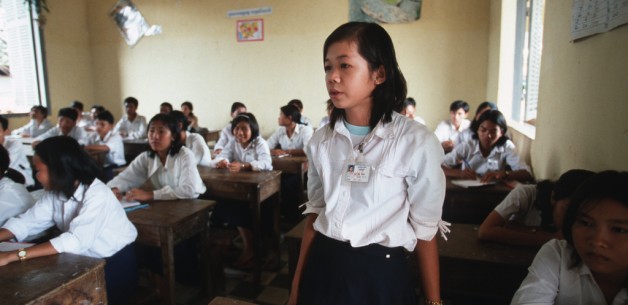Cambodia. Photo: © Masaru Goto / World Bank
The World Bank has long noted that investing in children is the clearest path to reducing poverty. Yet a lack of specific protections for children has led to many years of World Bank projects in Cambodia and around the world with unintended negative impacts. Today, the World Bank’s Board of Executive Directors is scheduled to meet and potentially approve several new projects for Cambodia. This meeting is significant. If the projects are approved, it will mark the first time in over five years that the Bank has made a new loan to Cambodia using its own funding. As the World Bank prepares to reengage in Cambodia, is it ready to invest in projects that will benefit children and ensure that their rights and well-being are protected?
In 2011, the World Bank froze all new lending to Cambodia due to the many failures of the Cambodia Land Management and Administration Project (LMAP). LMAP was established in 2002 with the stated aim of improving security of tenure for the poor and reducing land conflicts in Cambodia by systematically registering land and issuing titles across the country. For families living in Phnom Penh’s Boeung Kak Lake (BKL) community, LMAP failed to deliver on its promise. Residents of the BKL community were unjustly denied titles to their land, and in 2007 the government granted a 99-year lease to a private developer that filled the community’s lake with sand and involuntarily displaced thousands of families without adequate compensation.
The World Bank has now signaled that it is ready to reengage in Cambodia, and one of the first projects that is set to be approved today, the Land Allocation for Social and Economic Development II (LASED II) project, is to be carried out by the same implementing agency responsible for LMAP—the Ministry of Land Management, Urban Planning and Construction. The objective of LASED II is to help improve target beneficiaries’ access to agriculture resources, selected infrastructure and social services in project communities. But will the project be able to deliver its objective? Will new projects such as LASED II benefit the country’s children and ensure that their rights and well-being are protected?
If the first phase of LASED is any indication, the answer may be no. Designed to support the Government’s Social Land Concession (SLC) Program, the project distributed state land to over 3,000 poor families who were classified as either “landless” or “land poor.” According to the World Bank, the first phase of LASED was highly successful and the Bank’s website features a story on the project entitled, “Bringing Opportunity to Cambodia’s Poor and Landless Families.” There is no doubt that the project did serve to benefit some. However, there were also many families who were left behind.
According to the findings of field visits conducted in LASED project sites by the Cambodian League for the Promotion and Defense of Human Rights (LICADHO), many of the families who had received land under the first phase of LASED were not residing there. These families had moved to their new plots of land only to find that the soil was infertile. In addition, some of the land needed to be cleared for farming, but the families lacked the resources to do so. As a result, many families who moved to their new plots of land were unable to make a living and were still struggling to put enough food on the table.
Poor land quality was also a key point noted in a lessons learned report published by Deutsche Gesellschaft für Internationale Zusammenarbeit (GIZ) GmbH in early 2016. GIZ is a German development agency that provided technical assistance to the LASED project. Furthermore, GIZ states in its report that nearly all of the roads built during the LASED project were already deteriorating and that some SLCs also lacked functioning schools, health centers and a reliable water supply.
For children living on the project sites, access to education posed a real challenge. Although primary schools were constructed in most of the communities, many schools lacked teachers and failed to operate on a regular basis. In addition, some schools also experienced high drop out rates due to economic pressures faced by students’ families. Furthermore, due to a lack of operational health facilities and access to clean water at the sites, there is no doubt that the physical well-being of children was also in jeopardy.
Publically available project documents on LASED II fail to address critical questions around how such negative impacts on children will be avoided in this second phase. It is also important to note that most families who received land during the first LASED project still do not have land titles and the ownership of some land allocated to beneficiaries under the first LASED project remains under dispute. With such serious underlying problems in the first LASED project, how will the World Bank ensure that LASED II will benefit children, their communities, and successive generations? How will the World Bank ensure that the rights of children and all members of the communities are protected?
The World Bank cannot expect to achieve its twin goals of ending poverty and boosting shared prosperity if its projects continue to perpetuate the cycle of poverty faced by so many in Cambodia. Before implementing this project, the World Bank should carefully assess the risks to children and require robust mitigation measures to ensure that current and future generations can share in its benefits.
For more information, please contact Michelle Williams at mwilliams@bankinformationcenter.org.

